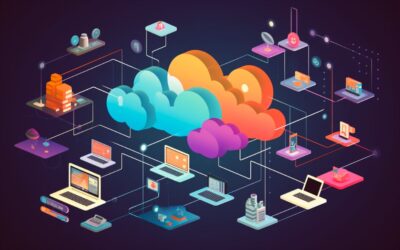If you had been told 15 years ago that software could be accessible from anywhere at anytime, would you have believed it? This is the reality today: a large part of our software is SaaS (Software as a Service) and available on the Cloud. It has gradually become less common that our collaborative needs to store, process, and share information are performed within the walls of the enterprise, or even on computers. Today, the use of server farms, aka Data Centers, located around the world is increasingly popular. Let’s take two minutes to focus on this cloud, and delve into the evolution of the hyperconnected software.
The miraculous transformation of software
We all remember how software was in the past: they were sold on CDs, or even floppy disks, and needed lots of time and work to be installed and the greediest amongst them required powerful computers. To the great advantage of the business community, IT technological developments have now made it possible to process and transfer information at the speed of light. We now store files in Dropbox, work with Google’s suite of online applications, organize and delegate tasks via Trello, and collaborate… On talkspirit. The advancements are such that even the good old email has migrated from software such as Outlook to the web.
Software as a Service (SaaS) is a miraculous software solution that enables the processing, storage, and sharing of information to no longer depend on you. These tasks take place directly on a server located in a Data Center, making the application accessible online at all times. This is nothing less than a revolution when comparing to how things were done 20 years ago.
Is SaaS the future of software solutions?
According to the market intelligence provider IDC (International Data Corporation), 25% of European companies currently use SaaS. Their total use represent more than 60% of the Public Cloud in Europe, a $60 billion market with a growth rate of 16% per year since 2016 (source IDC France) and shows no signs of weakening based on forecasts. Much traditional software have now transitioned to SaaS. This is the case for SalesForce, called CRM in its SaaS version, which has been able to expand their offer to VSEs / SMEs: cloud computing makes it possible to scale the offer to the needs of the client. Indeed, the IT market has quickly complied to this new reality and we can now find subscriptions to various kinds of applications, marking a clear departure from the traditional licensed machine installed software.
Established tech companies and startups are asking the cloud based model. It allows them to easily create, test, and integrate a solution, while lowering infrastructure overheads and integration time. The Harvard Business Review reported that an entrepreneur specializing in payment options reduced his integration time from 18 months to only 5 weeks. Such benefits have such a positive impact that SaaS could transform the software landscape.
An increasingly cloudy world
The growth of SaaS has spearheaded a change in the software market: we now have many more solutions related to niche issues, integrating with other software to complement client needs. The needs of an application development team will differ from the ones of a marketing department, but that won’t prevent them from collaborating with each other at one time or another in order to achieve their common objectives. We imagine a future where even operating systems will be online, where our smartphones will be just empty shells combined with a massive choice of applications. What can stop this evolution?
Two elements could be causes for concern. Firstly, cybersecurity. Beyond the number of cyberattacks and despite the recent trend to encrypt all data to allow safe transfers, there’s still much scepticism surrounding sensitive business information, as is the case in the banking sector. Secondly, a heavy reliance on internet access. An accident on a data centre could potentially cripple hundreds, if not thousands, of services. Fortunately, we’re far from the world of Black Mirror: cloud providers are often 3 steps ahead of worst case scenarios and continue to develop systems to shield them from such instances.
The digital transformation is gaining over the traditional software. This is one of the most welcomed changes for companies and for individual users: benefits include an increased mobility, more flexible business models, a plethora of new solutions integrating with each other, increased competition, which all improve the user experience. This is perhaps the key element of the digital transformation: improving our tools in order to be better prepared for the challenges of the future.



